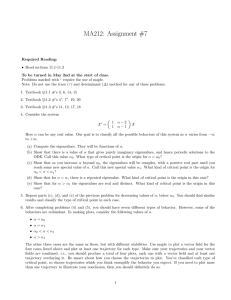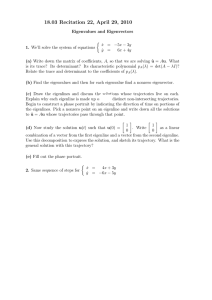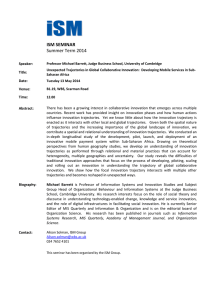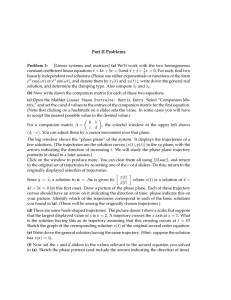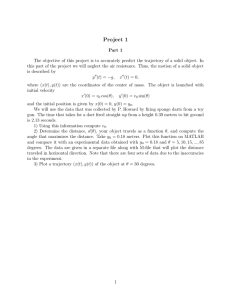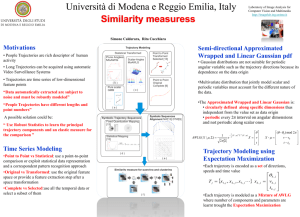Targeting Specific Distributions of Trajectories in MDPs David L. Roberts ,
advertisement
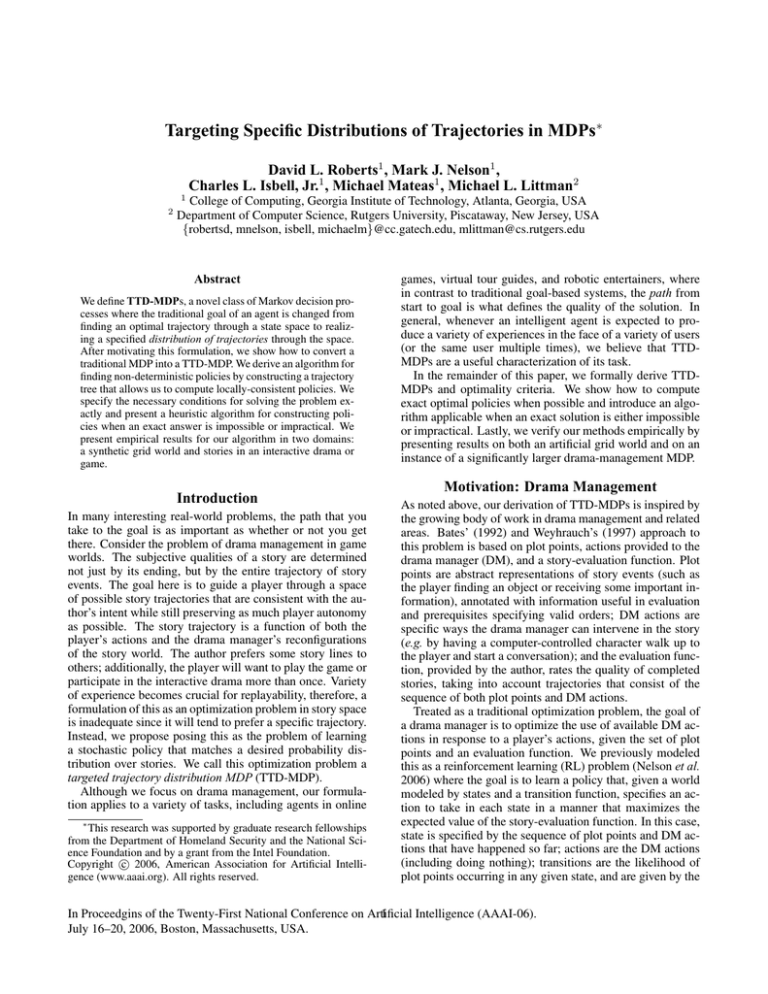
Targeting Specific Distributions of Trajectories in MDPs∗
College of Computing, Georgia Institute of Technology, Atlanta, Georgia, USA
Department of Computer Science, Rutgers University, Piscataway, New Jersey, USA
{robertsd, mnelson, isbell, michaelm}@cc.gatech.edu, mlittman@cs.rutgers.edu
1
2
David L. Roberts1 , Mark J. Nelson1 ,
Charles L. Isbell, Jr.1 , Michael Mateas1 , Michael L. Littman2
Abstract
We define TTD-MDPs, a novel class of Markov decision processes where the traditional goal of an agent is changed from
finding an optimal trajectory through a state space to realizing a specified distribution of trajectories through the space.
After motivating this formulation, we show how to convert a
traditional MDP into a TTD-MDP. We derive an algorithm for
finding non-deterministic policies by constructing a trajectory
tree that allows us to compute locally-consistent policies. We
specify the necessary conditions for solving the problem exactly and present a heuristic algorithm for constructing policies when an exact answer is impossible or impractical. We
present empirical results for our algorithm in two domains:
a synthetic grid world and stories in an interactive drama or
game.
Introduction
In many interesting real-world problems, the path that you
take to the goal is as important as whether or not you get
there. Consider the problem of drama management in game
worlds. The subjective qualities of a story are determined
not just by its ending, but by the entire trajectory of story
events. The goal here is to guide a player through a space
of possible story trajectories that are consistent with the author’s intent while still preserving as much player autonomy
as possible. The story trajectory is a function of both the
player’s actions and the drama manager’s reconfigurations
of the story world. The author prefers some story lines to
others; additionally, the player will want to play the game or
participate in the interactive drama more than once. Variety
of experience becomes crucial for replayability, therefore, a
formulation of this as an optimization problem in story space
is inadequate since it will tend to prefer a specific trajectory.
Instead, we propose posing this as the problem of learning
a stochastic policy that matches a desired probability distribution over stories. We call this optimization problem a
targeted trajectory distribution MDP (TTD-MDP).
Although we focus on drama management, our formulation applies to a variety of tasks, including agents in online
This research was supported by graduate research fellowships
from the Department of Homeland Security and the National Science Foundation and by a grant from the Intel Foundation.
c 2006, American Association for Artificial IntelliCopyright °
gence (www.aaai.org). All rights reserved.
∗
games, virtual tour guides, and robotic entertainers, where
in contrast to traditional goal-based systems, the path from
start to goal is what defines the quality of the solution. In
general, whenever an intelligent agent is expected to produce a variety of experiences in the face of a variety of users
(or the same user multiple times), we believe that TTDMDPs are a useful characterization of its task.
In the remainder of this paper, we formally derive TTDMDPs and optimality criteria. We show how to compute
exact optimal policies when possible and introduce an algorithm applicable when an exact solution is either impossible
or impractical. Lastly, we verify our methods empirically by
presenting results on both an artificial grid world and on an
instance of a significantly larger drama-management MDP.
Motivation: Drama Management
As noted above, our derivation of TTD-MDPs is inspired by
the growing body of work in drama management and related
areas. Bates’ (1992) and Weyhrauch’s (1997) approach to
this problem is based on plot points, actions provided to the
drama manager (DM), and a story-evaluation function. Plot
points are abstract representations of story events (such as
the player finding an object or receiving some important information), annotated with information useful in evaluation
and prerequisites specifying valid orders; DM actions are
specific ways the drama manager can intervene in the story
(e.g. by having a computer-controlled character walk up to
the player and start a conversation); and the evaluation function, provided by the author, rates the quality of completed
stories, taking into account trajectories that consist of the
sequence of both plot points and DM actions.
Treated as a traditional optimization problem, the goal of
a drama manager is to optimize the use of available DM actions in response to a player’s actions, given the set of plot
points and an evaluation function. We previously modeled
this as a reinforcement learning (RL) problem (Nelson et al.
2006) where the goal is to learn a policy that, given a world
modeled by states and a transition function, specifies an action to take in each state in a manner that maximizes the
expected value of the story-evaluation function. In this case,
state is specified by the sequence of plot points and DM actions that have happened so far; actions are the DM actions
(including doing nothing); transitions are the likelihood of
plot points occurring in any given state, and are given by the
In Proceedgins of the Twenty-First National Conference on Artificial
1
Intelligence (AAAI-06).
July 16–20, 2006, Boston, Massachusetts, USA.
combination of prerequisites for a plot point, the player, and
any influence from drama-manager actions; and the evaluation function is the one provided by the author.
While this approach has proven promising, it is clear that
it has its limitations. Specifically, if there is a policy that
allows the drama manager to guide the player to the same
highly-rated story every time, the RL process will consider
that an effective solution even though this limits replayability. Any distribution over good outcomes is an artifact of
the stochasticity introduced by the user rather than the result
of reinforcement learning. As such, it becomes difficult to
optimize for the distribution.
Rather than attempting to maximize any given episode,
the goal should be to maximize long-term enjoyment by
achieving a target distribution over highly-rated episodes. In
other words, one should learn a stochastic policy that produces a distribution over actions rather than a policy that
chooses a specific action.
taken. Note, that because we require a finite number of trajectories for the TTD-MDP, in this formulation the MDP
cannot have cycles.
Dealing with trajectories means that the “state” space of
the TTD-MDP forms a tree. The power of this insight becomes evident when we restate Equation 1 for TTD-MDPs:
X
P (t0 ) =
(P (t0 |a, t) · P (a|t)) · P (t).
(2)
∀a∈At
In other words, for every partial or full trajectory t0 , the transition probability P (t0 |a, t) is nonzero for exactly one t @ t0
that is its prefix. This observation follows from the fact
that each trajectory represents a unique sequence of states
s1 , . . . , sktk and therefore has a unique prefix. Thus, the
summation need only account for possible actions taken in
the preceding trajectory rather than actions in multiple MDP
states. Because each trajectory has a fixed length and can
therefore appear at only one specific time, we can drop the i
subscripts.
Finally, we need a target distribution. In general, any arbitrary target distribution can be used. There are a variety
of ways one might imagine encoding a distribution. In this
work we will focus on the case where a distribution has been
specified and may be queried.
We can now define an algorithm to compute a policy
P (a|t) for every partial trajectory in T .
1: Build a tree of all possible trajectories.
2: Initialize each leaf node (complete trajectory) with its
target probability P (t).
In reverse topological order:
3: for Every t do
4:
for Every child t0i of trajectory t do
5:
Condition Equation 2 on t:
X
P (t0i |t) =
(P (t0i |a, t) · P (a|t))
TTD-MDPs
A typical MDP is defined by a tuple (S, A, P, R), where S
is a set of states, A is a set of actions, P : {S × A × S} →
[0, 1] is a transition function, and R : S → R is a reward
function. The solution to an MDP is a policy π : S → A.
An optimal policy ensures that the agent receives maximal
long-term expected reward.
A TTD-MDP shares components with a traditional
MDP. Specifically, a TTD-MDP is defined by a tuple
(T , A, P, P (T )), with states T that are partial or complete
finite-length trajectories of MDP states; a set of actions A; a
transition model P ; and a target distribution over complete
trajectories P (T ).1 Note that the target distribution replaces
the reward function. The solution to a TTD-MDP is a policy
π : T → P (A) providing a distribution over actions in every state. The optimal policy results in long-term behavior
as close to the target distribution as possible.
Any finite-length discrete-time MDP can be converted to
a TTD-MDP. Consider an MDP with a set of states S and
sets of actions available in each state As , the probability
Pi+1 (s0 ) that the process is in state s0 at time i + 1 is defined recursively by:
X
Pi+1 (s0 ) =
(P (s0 |a, s) · P (a|s) · Pi (s))
(1)
∀a∈At
6:
7:
∀s∈S,a∈As
end for
This forms a system of |Tt0i | linear equations in |At |
unknowns:
P~ (t0i |t) = P~ (t0i |a, t) · ~π (t)
which can be solved for π using standard linear algebra.2
Substitute π into Equation 2 and determine if there is
at least one non-zero product of a row and column.
if There is no non-zero product then
P (t) = 0
else
P
P (t) = i P (t0i )
end if
end for
8:
where P (s0 |a, s) is the transition model encoding the dynamics of the world and P (a|s) is the policy under the
agent’s control. During an actual episode, Pi (s) = 1; if
we assume (as is commonly done) that the policy is deterministic, weP
get a common form of Equation 1, rewritten as:
Pi+1 (s0 ) = ∀s∈S,a∈As P (s0 |π(s), s).
Because we are interested in trajectories in TTD-MDPs,
we can simply roll the history of the MDP states into the
TTD-MDP trajectories, resulting in an TTD-MDP where
each trajectory represents a sequence of states in the underlying MDP, optionally including a history of the actions
9:
10:
11:
12:
13:
14:
2
In order to have a well specified linear system it is necessary
for the number of trajectories reachable from the current trajectory
to be at least as large as the number of available actions. If this is
not the case, the action taken can be included in the representation
of the trajectory so the same state-based trajectory will appear to be
different depending on the action. This procedure ensures at least
as many trajectories as actions.
1
As we shall see, the inclusion of actions in the trajectory allows
us to ensure that our TTD-MDP is not underconstrained.
2
In steps (9)-(13), we identify when no non-zero product
of rows of P~ (t0i |a, t) and the column vector ~π exists. If there
is no non-zero product, then there is no policy that will satisfy any percentage of the goal probability P (t0i ) and we set
P (t) = 0.
the normalization to Pb(a|t0 )) and Y is the desired distribution. While we have not yet proven that our normalization
procedure hits this lower bound, empirical analysis indicates
that it always does.3
Intractable Problems
Our algorithm builds a trajectory tree. In practice, the trajectory tree may be infeasible to compute and store, or completely specifying a distribution over all trajectories may be
difficult or impossible. Here, we introduce a method for
solving TTD-MDPs in this case. The basic strategy is to
sample some number of trajectories from P (T ) and build a
smaller tree based on those.
1: Pick some Ts ⊂ T to sample and construct a distribution. We chose the empirical distribution:
(
0.0
if P (t) < φ
e
P (Ts ) = P (t)
otherwise
C
Practical Issues
Impossible Constraints
When an exact solution is obtainable the algorithm will return an optimal policy; however, this is not always possible.
There are two types of errors we can encounter. First, there
may be no vector ~π (t) that satisfies the linear system exactly.
Second, even when there is an exact solution, the elements
of ~π (t) may not be probabilities (though they will still sum
to 1.0).
Lemma 1. For a given trajectory t with subsequent trajectories t01 , . . . , t0n and actions a1 , . . . , am , the following condition is sufficient for there to be no exact solution to the
system of equations where the entries of ~π (t) are probabilities:
∃i such that either
∀a :P (t0i |a, t) < P (t0i |t)
(3)
or ∀a :P (t0i |a, t) > P (t0i |t)
(4)
by normalizing the desired probabilities of all sampled
trajectories above some given threshold φ.
2: Build a trajectory tree using Ts and Pe (Ts )
3: Solve the resulting problem using the algorithm from
above, picking some recovery mechanism for action selection once a trajectory not sampled is encountered.
We assume that it is most important to reduce error on
the high-probability trajectories. This method focuses on reducing overall error in the approximation by ensuring that
the areas of the trajectory space that could potentially contribute the largest local error are solved as accurately as possible. Even if the evaluation sampling “falls out of” the set
of sampled trajectories Ts (e.g. if non-determinism causes an
undesirable action outcome), we still maintain several nice
characteristics. If our deviation from the sampled trajectory
tree is near the root, it is likely that most or all of the subsequent trajectories have low probability in P (T ) (and were
therefore not included in Pe(Ts )). On the other hand, if an
evaluation sample falls out of the set of sampled trajectories
far down the tree, it is likely that it will result in trajectory
with a high desired probability because that part of the trajectory space is more heavily represented in Ts . In other
words, the effects of sampling error are minimized when it
is possible to do well and maximized in the cases where it
would have been impossible to do well.
Proof. The proof follows from the observation that unless
the probabilities of two actions bracket the desired distribution (or at least one matches exactly) there is no convex
combination of actions that can result in the desired distribution.
Corollary 2. If the system has an exact solution, then for
every t0i , there exist aj , ak such that P (t0i |aj , t) ≤ P (t0i |t)
and P (t0i |ak , t) ≥ P (t0i |t).
For example, consider a trajectory t0 , three subsequent trajectories t1 , t2 , t3 and three actions a1 , a2 , a3 whose linear
system is defined by:
"
# "
#
0.0
0.5 0.5 0.0
0.3333 = 0.0 0.5 0.5 · ~π (t)
(5)
0.6667
0.5 0.0 0.5
Then, the solution vector
~π (t) =
"
0.3333
−0.3333
1.0000
#
does not represent a probability distribution.
While this solution is not a vector of probabilities, it does
satisfy the linear system. Intuitively, achieving the desired
distribution requires that action a2 be “undone” some percentage of the time. Since it is impossible, in practice we
zero out any negative values and renormalize. We have derived a lower bound on error when Lemma 1 holds for only
one trajectory tj : kYb − Y k1 = kP~ (ti |a, t0 ) · π
b(t) − Y k1 ≥
2 × [mina |P (tj |a, t0 ) − P (tj )|] where Yb is the distribution
of trajectories for a particular choice of policy π
b(t) (e.g after
Results
To test the feasibility and accuracy of our algorithm, we
ran experiments on a synthetic grid world and the dramamanagement MDP we previously studied.4 The synthetic
grid world is a square-grid MDP where there are at most two
actions in every state; a start state s0 = (0, 0) and goal state
sg = (n, n); and a known transition model P (s|a, s0 ). The
3
When Lemma 1 does not hold, we have found examples where
the L1 error is less than this bound.
4
For more details on the drama management MDP, see Nelson et al. (2006) or Nelson & Mateas (2005).
3
Varying Degrees of Sparsity with Deterministic Actions
0.18
Varying Degrees of Sparsity with Nondeterministic Actions
0.9
10x10
10x10 (5x)
9x9
7x7
5x5
0.16
0.14
0.7
0.6
L1 error
0.12
L1 error
5x5
7x7
9x9
10x10
0.8
0.1
0.08
0.5
0.4
0.06
0.3
0.04
0.2
0.02
0.1
0
0
0
0.1
0.2
0.3
0.4
0.5
0.6
0.7
0.8
0.9
1
0
Percent of Trajectories Targeted
0.1
0.2
0.3
0.4
0.5
0.6
0.7
0.8
0.9
1
Percent of Trajectories Targeted
Figure 1: Percent Error evaluating with 1,000,000 samples as a function of target distribution sparsity with deterministic and
non-deterministic actions.
by Nelson & Mateas (2005).
To evaluate the effect of a drama manager, we run simulated stories and plot a distribution of story qualities. The
drama manager’s goal is to increase the frequency of highlyrated stories and decrease the frequency of low-rated stories. In particular, we would prefer that very low-rated stories never happen, while achieving a good distribution over
highly-rated stories. We use the evaluation function and
these preferences to define a TTD-MDP: Any story (trajectory of plot points) that evaluates below a threshold has a target frequency of 0, while those above the threshold should
all appear, with the highly-rated ones more likely.
We build a tree from a set of sampled stories, which we
can solve exactly. Unfortunately, during evaluation or actual
gameplay, it is often the case that non-determinism in our
player model causes us to encounter story trajectories not
in the tree. We show results from two recovery strategies.
In the first, the system always takes a domain-specific fallback action. In the second, online sampling search is used;
that is, the system locally simulates possible stories from the
current trajectory and uses the results to choose an action. In
general, we find that what is best to do is domain specific.
Although not shown, we also tried acting randomly to recover but that, unsurprisingly, proved to always be worse
than doing nothing. It is a characteristic of TTD-MDPs in
general that the path to the goal is what is important and
therefore acting in an unprincipled manner can almost never
be beneficial.
Figure 2 shows several story-quality distributions. In
these experiments, our target distribution avoids any stories
with a quality of less than 0.55, while skewing slightly towards highly-rated stories. The baseline shows the distribution of story qualities when no drama manager is used;
SAS+ is Weyhrauch’s sampling search; TTD:Null is the
TTD-computed policy with all null actions taken when the
system encounters an unknown trajectory; TTD:SAS+ is the
hybrid sampling approach; and RL is an RL-trained policy.
Compared to no drama management, SAS+ increases the
number of highly-rated stories, but also results in more very
poorly-rated stories. TTD:Null results in nearly the opposite
of what we intended, increasing the number of low-rated sto-
two actions are “move right” and “move up” with the obvious meanings. Having only two actions prevents infinitelength trajectories.
We ran trials with and without deterministic actions. We
also tested with various target distributions. For each trial,
we selected a complete trajectory with some probability.
Each selected trajectory was given uniform target probability and the remainder were given zero target probability. We
varied the selection probability from 0.05 to 1.0. We then
built the tree and computed a policy that was used to generate 1,000,000 samples. The relative frequency of each
trajectoryP
was compared against its target and error was reported as t∈T |P (t) − Emp(t)| (where Emp(t) is the frequency of t during sampling evaluation). Lastly, we varied
the size of the grid from 5 × 5 to 10 × 10. For each set of
parameters, we ran 10 trials and averaged the results.
When all actions are deterministic, an exact policy can
be easily computed. We plot the results of these trials in
Figure 1 to illustrate the effect of sampling error. Not surprisingly, the L1 error increases as either the size of the grid
world increases or as the percentage of complete trajectories
with non-zero target probability increases. Using 5,000,000
samples in the 10 × 10 grid world reduces this error by half.
A similar experimental setup was used to test the result
of non-deterministic actions. Here, as the percentage of
complete trajectories with non-zero target probability is increased, the error is reduced; however, as one would expect,
absolute error is significantly higher (note the scale of the
graphs in Figure 1). Intuitively, when only a few of the trajectories are desirable, any non-determinism in the outcome
of actions may result in a trajectory with zero desired probability.
To test on a real-world application—one that is computationally intractable to solve exactly—we used a version
of the Anchorhead story on which we have previously explored using RL (Nelson et al. 2006). In our model, Anchorhead has 29 plot points and 90 drama-manager actions.
The evaluation function is a combination of features, such
as the spatial locality of action, having plot points occur in
an order that motivates later events, and so on; more details
on the general framework and evaluation functions are given
4
Large story: Baseline, SAS+, and TTD:Null
0.45
Large story: Baseline, RL, and TTD:SAS+
0.45
Baseline
SAS+
TTD:Null
0.4
0.4
0.35
0.35
0.3
Frequency
0.3
Frequency
Baseline
RL
TTD:SAS+
0.25
0.2
0.15
0.25
0.2
0.15
0.1
0.1
0.05
0.05
0
0
0.4
0.45
0.5
0.55
0.6
0.65
0.7
0.75
0.8
0.4
Story quality
0.45
0.5
0.55
0.6
0.65
0.7
0.75
0.8
Story quality
Figure 2: Graph of drama management results with and without TTD-MDPs as well as results based on threshold and/or with
and without SAS+ or online policy adaption.
method in which they use a generative model of observations
and transitions to construct trajectory trees in POMDPs.
Their method uses a sampling approach where a number of
sampled trajectory trees are used in aggregate to estimate
the value of a particular policy. In our case, we construct
one trajectory tree without a generative model and use it to
to solve for a policy, rather than to estimate its value.
Littman (1994) uses Markov games as a framework for
exploring reinforcement learning in the presence of multiple adaptive agents. Our formulation is similar in that it acknowledges a source of randomness outside the environment
itself, finding a solution that requires a stochastic policy. On
the other hand, this work was not directly concerned with
distributions over outcomes, and assumed a zero-sum game.
In the formulation of the drama-management problem, the
game is not zero-sum: the player and the drama manager
are, in effect, playing completely different games.
If we think of TTD-MDPs as looking at the dynamics of
an MDP, but holding non-traditional elements fixed, then we
find common ground with recent work in inverse reinforcement learning (Ng & Russell 2000). In this formulation, the
goal is to observe the policy of an agent and then infer the
reward function that led to its behavior. In the drama management case, non-determinism arises from the user but also
from our actions. If we think of the desired distribution then
the non-determinism that is not explained by the user model
is exactly the distribution over our own actions.
ries. The distribution resulting from RL is an impulse at the
top of the story-quality range, illustrating that RL is solving
quite a different problem, as it results in a handful of the
same stories happening repeatedly. TTD using SAS+ as a
fallback, however, yields results consistent with our target
distribution: TTD:SAS+ has virtually no stories below the
target cutoff of 0.55, and a nice distribution of stories above.
It appears that the sampling used to populate the trajectory
tree finds prefixes common to the stories above the threshold. Solving the TTD-MDP results in a policy that keeps
the agents on these trajectories as long as possible; once the
agent falls out of this space, it is not only already in a good
part of the space, but the number of remaining trajectories
has been reduced enough to make a sampling search feasible and effective.
To better understand the effects of approximating a solution to a TTD-MDP by sampling trajectories, we explored
a smaller story with only 9 plot points and 28 DM actions.
Figure 3 shows a similar improvement between using the
null fallback action and sampling search; however, we also
found that varying the number of samples used to build the
trajectory tree has minimal effect on the resulting distribution. In this case, increasing from 10,000 to 100,000 samples
did have an effect, but further increasing to 2,000,000 had no
effect on performance. This suggests that this method may
perform well on even larger problems.
Related Work
Conclusions and Future Work
Although our formulation is novel, there has been some
work that addresses some of the issues raised here. For example, one attempt to achieve a distribution over actions for
reasons other than trading off exploration and exploitation
came out of work with Cobot, an agent that interacted with
humans in a socially-complex virtual environment (Isbell et
al. 2001). There, state-action Q-values were used to induce
a distribution over actions. This choice resulted in a distribution biased towards positive outcomes (as was Cobot’s
goal), but did not target any specific distribution, nor directly
take into account the way in which locally stochastic action
selection affected the global distribution of outcomes.
Kearns, Mansour, & Ng (2000) describe a trajectory-tree
We have presented a new class of Markov decision problems
where matching a target distribution replaces the goal of
maximizing expected reward. Additionally, we have specified two approaches for solving TTD-MDPs.
We believe that the problem TTD-MDPs address—
namely matching desired distributions over outcomes and
trajectories—is a fertile area for both theoretical and practical treatment. In the short term we are interested in deriving
tighter bounds on the error that can be achieved in TTDMDPs, particularly under error measures other than L1 .
We also intend to explore the case where target distributions are not readily available. For example, authors may
5
Small story: Baseline, TTD:Null, and TTD:SAS+
0.3
0.25
Small story: Effect of sample size
0.25
Baseline
TTD:Null
TTD:SAS+
10k samples
100k samples
2m samples
0.2
Frequency
Frequency
0.2
0.15
0.15
0.1
0.1
0.05
0.05
0
0.25
0.3
0.35
0.4
0.45
0.5
0.55
0.6
0
0.25
0.65
Story quality
0.3
0.35
0.4
0.45
0.5
0.55
0.6
0.65
Story quality
Figure 3: Graph of drama-management results on a small story, confirming the effects of SAS+ combined with TTD, and
illustrating the effects of sample size on the quality of TTD policies.
Ng, A. Y., and Russell, S. 2000. Algorithms for inverse reinforcement learning. In Proceedings of the Seventeenth International Conference on Machine Learning
(ICML-00), 663–670.
Weyhrauch, P. 1997. Guiding Interactive Drama. Ph.D.
Dissertation, School of Computer Science, Carnegie Mellon University, Pittsburgh, PA. Technical Report CMU-CS97-109.
find it difficult to write down a distribution, but are comfortable with specifying a story-evaluation function. Unfortunately, it is not clear that the evaluation function will lead to
the author’s desired distribution. The problem becomes one
of also modifying the evaluation function so that it leads to
the target distribution.
Additionally, we are interested in scaling TTD-MDPs to
apply to even larger problems. One approach is to deal with
sample error in the trajectory tree by dynamically adapting the tree through pruning existing subtrees and adding
new subtrees as better estimates of the desired distribution
become available. Another approach would use an online
model-free method where the trajectory tree is never explicitly represented.
References
Bates, J. 1992. Virtual reality, art, and entertainment. Presence: The Journal of Teleoperators and Virtual Environments 1(1):133–138.
Isbell, Jr., C. L.; Shelton, C. R.; Kearns, M.; Singh, S.; and
Stone, P. 2001. A social reinforcement learning agent. In
Proceedings of the Fifth International Conference on Autonomous Agents (Agents-01), 377–384.
Kearns, M.; Mansour, Y.; and Ng, A. Y. 2000. Approximate planning in large POMDPs via reusable trajectories.
Advances in Neural Information Processing Systems 12.
Littman, M. L. 1994. Markov games as a framework for
multi-agent reinforcement learning. In Proceedings of the
Eleventh International Conference on Machine Learning
(ICML-94), 157–163.
Nelson, M. J., and Mateas, M. 2005. Search-based drama
management in the interactive fiction Anchorhead. In Proceedings of the First Annual Conference on Artificial Intelligence and Interactive Digital Entertainment (AIIDE-05).
Nelson, M. J.; Roberts, D. L.; Isbell, Jr., C. L.; and
Mateas, M. 2006. Reinforcement learning for declarative
optimization-based drama management. In Proceedings
of the Fifth International Joint Conference on Autonomous
Agents and Multiagent Systems (AAMAS-06).
6
